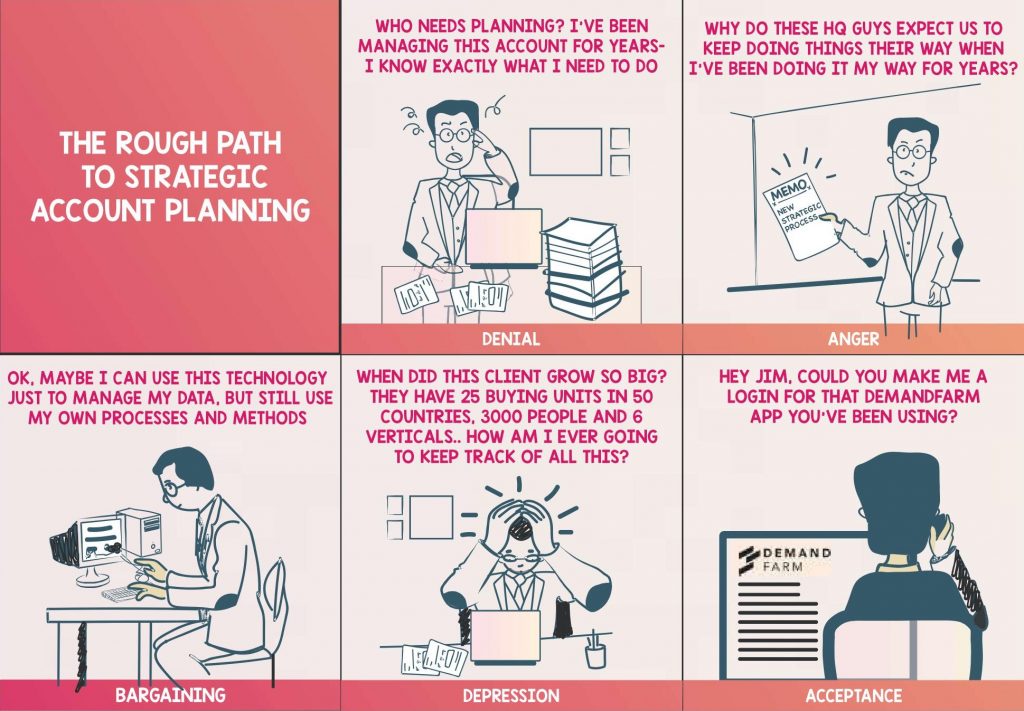In today’s sales landscape, implementing a successful Key Account Management (KAM) strategy can often mean the difference between success and failure. However, with the rise of digital technology, traditional KAM strategies may no longer be enough to meet the needs of the modern customer. This is where digital Key Account Management (DKAM) enters the scene. By allowing companies to leverage data and technology digital Key Account Management provides a more personalized and customer-centric approach to sales.
In fact, according to a recent survey, 84% of sales leaders believe that digital Key Account Management is crucial to their organization’s success. Despite this, many sales leaders and sales enablement leaders have challenges with developing and implementing effective digital Key Account Management strategies that align with their company’s goals and objectives.
Whitepaper: The Impact of Digital Key Account Management on Sales Enablement
Here, you’ll discover the best practices for developing a digital Key Account Management strategy. One that will meet the specific needs of your customers and drive sales success. From identifying account management key performance metrics and setting clear objectives to tailoring your approach to each customer and measuring your results – you’ll find all you need to know to succeed in today’s digital business ecosystem.

Key Components of Digital Key Account Management
B2B companies today are increasingly adopting digital strategies to stay competitive. For sales leaders and sales enablement leaders developing a Key Account Management strategy is essential. This helps with building strong and lasting relationships with key customers but also adapting to the changing needs of their customers.
However, successful implementation of digital Key Account Management requires a deep understanding of its key components and features. Here are some fundamental elements of digital Key Account Management, including how it builds upon traditional Key Account Management practices and the essential components of a successful digital Key Account Management strategy.
Listen to The Shift: #1 Podcast on Digital Key Account Management
Overview of Traditional Key Account Management and its Translation to the Digital World:
Traditional Key Account Management involves building strong relationships with key customers to drive long-term growth and profitability. However, in the digital age, businesses must also leverage technology to improve customer experiences and foster deeper relationships.
Digital Key Account Management involves using data analysis and personalized communication to provide these exact results. By intelligently using digital tools and platforms, businesses can gain a deeper understanding of their key accounts’ needs and preferences, and tailor their approach accordingly.
Key Features of Successful Digital Key Account Management:
Effective digital Key Account Management involves several key features, including:
- Customer-centric approach: In the B2B sector, customers are looking for personalized solutions that meet their unique needs. A digital Key Account Management strategy should prioritize a customer-centric approach that puts the customers’ needs at the forefront.
- Data analysis: One of the advantages of a digital approach to Key Account Management is the ability to collect and analyze data. By analyzing customer data and interactions, sales teams can identify trends and opportunities to improve customer engagement and retention.
- Personalized communication: Effective and clear communication is critical to building strong relationships with key accounts. A digital Key Account Management strategy should include personalized communication that directly addresses the customer’s needs and preferences.
- Customer feedback: Gathering feedback from key accounts is essential to understanding their needs and identifying opportunities for improvement. A digital approach allows for easy collection and analysis of customer feedback. It thus enables sales teams to quickly adapt and respond to customer needs.
These key components must be part of every digital Key Account Management strategy. By incorporating these features, sales leaders and sales enablement leaders will be on the path to providing exceptional customer service, building better relationships with key accounts and enhancing business performance.
Developing Your Digital Key Account Management Plan
B2B clients today conduct active research online. In fact, over 60% of all B2B transactions start online.
Also, close to 90% of B2B CMOs believe that customer experience will be more critical in the industry in the years ahead.
These statistics highlight the importance of a well-planned and executed digital Key Account Management strategy. To stay in the race and outperform the competition, businesses must think creatively and incorporate innovative approaches into their plan.
Learn More: 7 Key Takeaways for a Successful Key Account Management Transformation Journey
Here are some key steps to consider when developing your digital Key Account Management plan:
1. Set clear objectives and goals for your digital strategy:
It’s important to start by identifying the key objectives and goals of your digital strategy. What are you hoping to achieve with your key accounts? What specific outcomes do you want to see? Having clear goals in mind will help you focus your efforts and measure your progress.
2. Identify key performance metrics and KPIs to track progress:
Once you’ve established your goals, it’s critical to identify the account management key performance metrics and KPIs that will help you track your progress. Metrics that could be included are revenue growth, lead conversion rates, and customer satisfaction. By tracking these metrics over time, you can identify what’s working and what’s not and make adjustments as needed.
Learn More: Key MetricsTo Measure The Success Of Your Digital Key Account Management Program
3. Create a framework for your digital strategy that aligns with company goals and objectives:
It’s important to ensure that your digital Key Account Management plan is aligned with your company’s broader goals and objectives. To do this you will need to create an Account Management framework that takes these goals and objectives into account. This could mean including elements like your company’s mission statement, core values and strategic objectives. By integrating these elements into your digital Key Account Management plan, you can ensure that your efforts are in line with your overall business strategy.
These steps will help you develop a comprehensive and effective digital Key Account Management plan that drives business growth. It also helps you build long-lasting relationships with your most valuable customers.

Implementing Your Digital Key Account Management Strategy
While developing a digital Key Account Management plan is crucial, its implementation is equally important. With the ability to tailor your approach to each customer’s specific needs and preferences, digital Key Account Management can help build stronger relationships. This ultimately leads to increased sales.
However, a successful strategy required a customized plan for each key account that leverages digital tools and platforms. This includes personalized email campaigns, targeted social media ads, or custom mobile apps.
Sales leaders and sales enablement leaders in the B2B sector must also ensure that their approach aligns with the overall goals and objectives of the company. By tracking and measuring KPIs, they can continually improve and adjust their approach as needed.
Here are some steps you can consider when implementing your digital Key Account Management strategy:
1. Tailor your approach to fit each customer’s needs and preferences:
Personalization is one of the key benefits of digital Key Account Management. By personalizing your approach to fit each customer’s specific needs and preferences you will build stronger relationships. This then leads to increased sales. When developing your approach consider factors such as the customer’s industry, buying behavior and communication preferences.
By harnessing customer data, you can create a customized approach that delivers a seamless and efficient experience. For instance, you can use data on their previous purchases to suggest relevant products. Data about their preferred communication channels will help you tailor your messaging. Tailoring your approach helps you demonstrate your value as a trusted partner that understands their unique needs.
2. Create a customized plan for each key account that leverages digital tools and platforms:
All successful digital Key Account Management strategies make the best use of digital tools and platforms to enhance customer engagement and experience. This could include personalized email campaigns, targeted social media ads, or even custom mobile apps.
By using digital tools, you can construct a personalized plan for each key account. This enhances customer experience and streamlines their interactions with your company. For example, you can use targeted social media ads to reach decision-makers at key accounts and promote your latest offerings. Or you can use custom mobile apps to provide real-time updates on orders, shipments and inventory levels.
3. Ensuring alignment with the company’s goals and objectives:
While personalization is key, it’s also important to ensure that your approach aligns with the overall goals and objectives of the company. This means regularly reviewing and refining your strategy to ensure it supports the company’s vision and values.
Additionally, be sure to track and measure the success of your strategy using key performance metrics and KPIs to continually improve and adjust your approach as needed. This will help you demonstrate the value of your Key Account Management strategy to other stakeholders in the company. It will also help you secure buy-in for future initiatives proposed.
Measuring and Evaluating Your Digital Key Account Management Strategy
After implementing your Key Account Management strategy, it’s essential to measure and evaluate its effectiveness. By tracking performance metrics and KPIs, analyzing customer feedback, and making data-driven improvements, you can continually optimize your results.
The steps that follow will help you measure and evaluate your digital Key Account Management strategy:
1. Track performance metrics and KPIs to assess the success
Key performance metrics and KPIs help you measure and evaluate the success of your strategy. For instance, you can track customer retention rates, revenue growth or the number of new accounts secured. By regularly monitoring these metrics, you can identify areas for improvement and make data-driven decisions to optimize your approach.
2. Analyze customer feedback and satisfaction to identify areas for improvement
Collecting feedback from your key accounts is essential to measure customer satisfaction and identify areas for improvement. You can conduct surveys, send out feedback forms, or regularly schedule check-ins to gather valuable insights. By analyzing this feedback, you can identify areas where you excel and areas where you need to improve. This will help you better adjust your approach to meet the needs of your key accounts.
3. Make data-driven improvements to your strategy to continually optimize your results
By leveraging data insights, you can make data-driven improvements to your strategy. This could mean tweaking your approach to address customer pain points, adjusting your communication channels, or improving your product offerings. By continually optimizing your approach you can increase customer satisfaction and maximize revenue potential.
Measuring and evaluating your Key Account Management strategy is critical to its success. Following these steps will help you refine your strategy over time and help you achieve better outcomes.
Best Practices for Successful Digital Key Account Management
As a sales leader or a sales enablement leader, you’re already aware that building strong relationships with your key accounts is key to driving revenue. But in the digital age, it takes more than just a handshake and a friendly phone call to make a lasting impression.
To succeed in digital Key Account Management, it’s essential to prioritize a customer-centric approach. This means taking the time to understand each customer’s needs, preferences and pain points and tailoring your approach accordingly. By doing so you foster trust and loyalty and establish yourself as a true partner invested in your customer’s business growth and success.
But how do you know what your customers want?
That’s where data comes in. With the right tools and analytics, you can gain valuable insights into their purchasing patterns, communication preferences and other metrics. Analyzing this data will help you make more informed decisions about how to best engage with your customers. This can lead to more targeted marketing campaigns, personalized messaging and other initiatives that drive engagement and loyalty.
Of course, technology is also a powerful asset that you can use to enhance customer experience. From personalized email campaigns and targeted social media ads to chatbots and custom mobile apps, there is a wide range of digital tools and platforms that can help you build stronger alliances with your key accounts. By providing customers with a hassle-free and streamlined experience, you can demonstrate your value as a trusted partner who actually understands what they need.
Digital Key Account Management is essential for B2B businesses looking to succeed in today’s competitive marketplace. And there are plenty of real-world examples of companies that have successfully implemented digital Key Account Management strategies.
Here are a couple:
- Cisco: The technology giant has implemented a digital Key Account Management strategy that focuses on building strong relationships with customers. This includes a personalized approach to customer service, targeted marketing campaigns and ongoing engagement through digital channels. As a result, Cisco has seen increased customer satisfaction and loyalty and improved revenue growth.
- Microsoft: Microsoft has implemented a digital Key Account Management strategy that makes the best use of data and technology to drive engagement and loyalty. This includes targeted marketing campaigns, personalized messaging and ongoing analysis of customer behavior and preferences. This has led to positive customer feedback and long-term retention for Microsoft, which has a positive effect on sales and business profitability.
The Difference Between Success and Failure in Digital Key Account Management
In today’s sales landscape, implementing a successful Key Account Management (KAM) strategy can mean the difference between success and failure. With the rise of digital technology, traditional KAM strategies may no longer be enough to meet the needs of modern customers.
The use of digital Key Account Management (DKAM) provides a more personalized and customer-centric approach to sales. Developing a successful digital Key Account Management strategy that meets the needs of your customer and drives sales success requires you to identify key components and features of DKAM.
Effective digital Key Account Management involves:
- understanding as much as you can about your customer
- analyzing the data collected
- using the data to orchestrate the best possible strategy and
- soliciting customer feedback.
These features should be at the heart of every digital Key Account Management strategy. It helps exceed the expectations of customer service, foster strong alliances with key accounts and enhance business performance.
To develop a comprehensive and effective digital Key Account Management plan, businesses must think creatively and incorporate innovative approaches into their plan. Key steps to consider when developing a digital Key Account Management plan include:
- setting clear objectives and goals,
- identifying key performance metrics and KPIs to track progress, and
- creating a framework to align with the company’s overall goals and objectives.
By integrating these elements into a digital Key Account Management plan, sales teams can identify trends and opportunities to improve customer engagement and retention, gather feedback from key accounts, and quickly adapt and respond to customer needs.
There’s no second-guessing the fact that a digital Key Account Management strategy is crucial to meet the needs of modern customers. By considering all the factors that go into making a digital Key Account Management strategy effective and successful, sales leaders and sales enablement leaders can put in place an excellent framework to build a sustainable and resilient business model.
Digital Key Account Management with DemandFarm
DemandFarm is a digital Account Planning partner that offers a modular, configurable, and highly agile approach to Key Account Management transformation. They understand what’s required in the current business environment and help organizations organize their key accounts more effectively.
Just as companies need to customize their offerings, DemandFarm’s products are designed to be highly configurable and can be tailored to cater to nuances of industry, account size and maturity. Further, their tools can be easily integrated with other apps and platforms. This allows the creation of a key account data ecosystem relevant to the organization’s needs.
With a modular, progressive and phased approach DemandFarm is a valuable partner for organizations looking to optimize their account planning process in the digital age.

